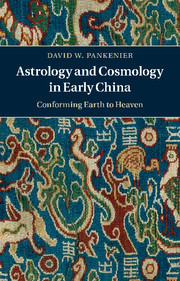Crossref Citations
This Book has been
cited by the following publications. This list is generated based on data provided by Crossref.
2014.
BOOKS RECEIVED FOR REVIEW.
Bulletin of the School of Oriental and African Studies,
Vol. 77,
Issue. 1,
p.
263.
Pankenier, David W.
2014.
DID BABYLONIAN ASTROLOGY INFLUENCE EARLY CHINESE ASTRAL PROGNOSTICATIONXING ZHAN SHU星占術?.
Early China,
Vol. 37,
Issue. ,
p.
1.
Galvany, Albert
2014.
Le stratège comme maître des signes : art de la guerre et art sémiotique en Chine ancienne.
Extrême-Orient, Extrême-Occident,
p.
65.
2014.
ANNUAL BIBLIOGRAPHY.
Early China,
Vol. 37,
Issue. ,
p.
625.
Galvany, Albert
2015.
SIGNS, CLUES AND TRACES: ANTICIPATION IN ANCIENT CHINESE POLITICAL AND MILITARY TEXTS.
Early China,
Vol. 38,
Issue. ,
p.
151.
Pankenier, David W.
2015.
Handbook of Archaeoastronomy and Ethnoastronomy.
p.
2085.
Damon, Frederick H.
2016.
Deep historical ecology: the Kula ring as a representative moral system from the Indo-Pacific.
World Archaeology,
Vol. 48,
Issue. 4,
p.
544.
McLeod, Alexus
2016.
Astronomy in the Ancient World.
p.
185.
Sloane, Jesse
2017.
The Cosmic, Political, and Personal in late Ming Travel Narratives to the Home of Confucius.
Ming Studies,
Vol. 2017,
Issue. 76,
p.
53.
Hayakawa, Hisashi
Iwahashi, Kiyomi
Tamazawa, Harufumi
Ebihara, Yusuke
Kawamura, Akito Davis
Isobe, Hiroaki
Namiki, Katsuko
and
Shibata, Kazunari
2017.
Records of auroral candidates and sunspots in Rikkokushi, chronicles of ancient Japan from early 7th century to 887.
Publications of the Astronomical Society of Japan,
Vol. 69,
Issue. 6,
Romain, William F.
2017.
The archaeoastronomy and feng shui of Xanadu: Kublai Khan’s imperial Mongolian capital.
Time and Mind,
Vol. 10,
Issue. 2,
p.
145.
Guo, Rongxing
2017.
An Economic Inquiry into the Nonlinear Behaviors of Nations.
p.
139.
Hayakawa, Hisashi
Tamazawa, Harufumi
Ebihara, Yusuke
Miyahara, Hiroko
Kawamura, Akito Davis
Aoyama, Tadanobu
and
Isobe, Hiroaki
2017.
Records of sunspots and aurora candidates in the Chinese official histories of the Yuán and Míng dynasties during 1261–1644.
Publications of the Astronomical Society of Japan,
Vol. 69,
Issue. 4,
Cheung, Christina
Jing, Zhichun
Tang, Jigen
Yue, Zhanwei
and
Richards, Michael P.
2017.
Examining social and cultural differentiation in early Bronze Age China using stable isotope analysis and mortuary patterning of human remains at Xin’anzhuang, Yinxu.
Archaeological and Anthropological Sciences,
Vol. 9,
Issue. 5,
p.
799.
Tamazawa, Harufumi
Kawamura, Akito Davis
Hayakawa, Hisashi
Tsukamoto, Asuka
Isobe, Hiroaki
and
Ebihara, Yusuke
2017.
Records of sunspot and aurora activity during 581–959 CE in Chinese official histories concerning the periods of Suí, Táng, and the Five Dynasties and Ten Kingdoms.
Publications of the Astronomical Society of Japan,
Vol. 69,
Issue. 2,
Chapman, J. J.
2018.
Ambiguity, Scope, and Significance: Difficulties in Interpreting Celestial Phenomena in Chinese Records.
Proceedings of the International Astronomical Union,
Vol. 14,
Issue. A30,
p.
152.
Montelle, Clemency
and
Plofker, Kim
2018.
Sanskrit Astronomical Tables.
p.
1.
Fujiyama, Masashi
Hayakawa, Hisashi
Iju, Tomoya
Kawai, Toshiki
Toriumi, Shin
Otsuji, Kenichi
Kondo, Katsuya
Watanabe, Yusaku
Nozawa, Satoshi
and
Imada, Shinsuke
2019.
Revisiting Kunitomo’s Sunspot Drawings During 1835 – 1836 in Japan.
Solar Physics,
Vol. 294,
Issue. 4,
Hoffmann, Susanne M
2019.
What information can we derive from historical Far Eastern guest stars for modern research on novae and cataclysmic variables?.
Monthly Notices of the Royal Astronomical Society,
Vol. 490,
Issue. 3,
p.
4194.
Lycas, Alexis
2019.
Monographs in Tang Official Historiography.
p.
287.



